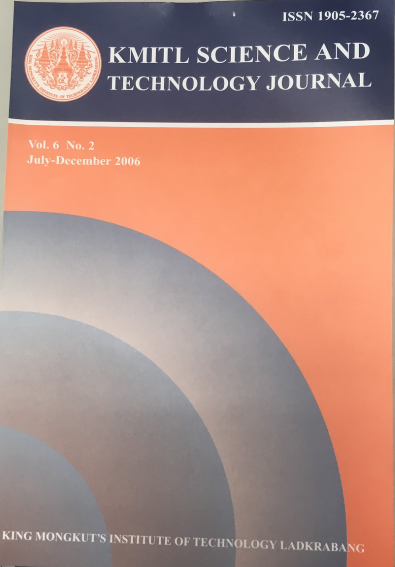ESTABLSHMENT OF CELL LINE DERIVED FROM EMBRYONIC TISSUE OF THE DLAMONDBACK MOTH, plutella xylostella (L.)
Main Article Content
Abstract
A new cell line designated KMITL-PX-E1 has been established from embryonic tissue of the diamondback moth, Plutella xylostella (L.). The primary cultures were seeded in TNM-FH medium supplemented with 20% fetal bovine serum and incubated at 28 °C. After the 18th passage, the cultures were adapted and maintained in TNM-FH medium supplemented with 10% fetal bovine serum. The cell line consisted of a mixture of two cell types, spindle-shaped cells and epithelial-like cells, both of them grew as attached monolayer. The population doubling time at the 2nd and the 18th passages were 110.59 and 61.22 hrs, respectively. The chromosome numbers varied from 6-124. Random amplified polymorphic DNA profile analysis showed that the diamondback moth cell line (KMITL-PX-E1) profile differed from the profiles of the beet armyworm (SE-1) and the American cotton bollworm (KMITL-HA-E1) cell lines maintained in the laboratory. KMITL-PX-E1 cell line supported replication of Autographa californica (AcMNPV) and Exoa scandens cytoplasmic polyhedrosis virus (EsCPV). However, this cell line was sensitive to Bacillus thuringiensis toxin.
Keywords: Plutella xylostella cell line, diamondback moth, nucleopolyhedrovirus, cytoplasmic polyhedrosis virus, Random amplified polymorphic DNA
Corresponding author: E-mail: ksounrua@kmitl.ac.th
Article Details
Copyright Transfer Statement
The copyright of this article is transferred to Current Applied Science and Technology journal with effect if and when the article is accepted for publication. The copyright transfer covers the exclusive right to reproduce and distribute the article, including reprints, translations, photographic reproductions, electronic form (offline, online) or any other reproductions of similar nature.
The author warrants that this contribution is original and that he/she has full power to make this grant. The author signs for and accepts responsibility for releasing this material on behalf of any and all co-authors.
Here is the link for download: Copyright transfer form.pdf
References
[2] Grace, T.D.C. 1982 Development of insect cell culture. In: Maramorosch, K. and Mitsuhashi, J. Invertebrate cell culture, applications. Academic Press, New York, pp. 1-8.
[3] Chen, Q. and Dai, X. 1987 Replication of Pieris rapae granulosis virus in an insect cell line. In: Kuroda, Y., Kursta, E. and Maramorosch, K. Invertebrate and fish tissue culture. Japan Scientific Societies Press, Tokyo, pp. 170-172.
[4] Lee, S.H. and Hou, R.F. 1992 Establishment of a cell line derived from embryos of the diamondback moth, Plutella xylostella (L.), J. Invertebr. Pathol., 59, 174-177.
[5] Petcharawan, O., Charoensak, S. and Belloncik, S. 2005 Establishment and characterization of cell line from embryonic tissue of the American cotton bollworm Helicoverpa armigera (Hübner) (Lepidoptera: Noctuidae). In: Qian, Y. and Ziniu, Y. Study on plant pest and disease biological control and biotechnology. Heilongjiang Science and Technology Press, pp. 107-121.
[6] Haymer, D.S., McInnis, D.O. and Arcangeli, L. 1992 Genetic variation between strains of the Mediterranean fruit fly, Ceratitis capitate, detected by DNA fingerprinting, Genome, 35, 528-533.
[7] Lery, X., Larue, B., Cossette, J. and Charpentier, G. 2003 Characterization and authentication of insect cell lines using RAPD markers, Insect Biochem. Molec. Biol., 33, 1035-1041.
[8] Nei, M. and Li, W. 1979 Mathematical model for studying genetic variation in terms of restriction endonucleases, Proc. Natl. Acad. Sci., 76, 5269-5273.
[9] Thomas, W.E. and Ellar, D.J. 1983 Bacillus thuringiensis var ieraelensis crystal δ- endotoxin: effects on insect and mammalian cells in vitro and in vivo, J. Cell Sci., 60, 181-197.
[10] Charpentier, G., Tian, L., Cossette, J., Lery, X. and Belloncik, S. 2002 Characterization of cell lines developed from the Colorado potato beetle, Leptinotarsa decemlineata Say (Coleoptera : Chrysomelidae), In Vitro Cell Dev. Biol., 38, 73-78.
[11] Kärber, G. 1931 Beitrag zur kolliktiven behandlung pharmakologischer reihenversuche Naunyn-Schwiedebergs, Arch. Exp. Pathol. Pharmakol., 162, 680-687.
[12] Mitsuhashi, J. 2002 Invertebrate tissue culture methods. Springer, Tokyo, 446 pp.
[13] Sudeep, A.B., Mourya, D.T., Shouche, Y.S., Pidiyar, V. and Pant, U. 2002 A new cell line from the embryonic tissue of Helicoverpa armigera HBN. (Lepidoptera: Noctuidae), In Vitro Cell Dev. Biol. Anim., 38, 262-264.
[14] Sieburth, P.J. and Maruniak, J.E. 1988 Susceptibility of and established cell line of Anticarsia gemmatalis (Lepidoptera: Noctuidae) to three nuclear polyhedrosis viruses, J. Invertebr. Pathol., 52, 453-458.


